UNIQUE SUPER RARE RSF SD-140 VINTAGE Drum Machine TR808 909 killer
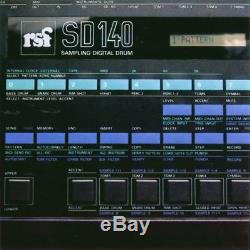
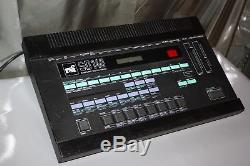
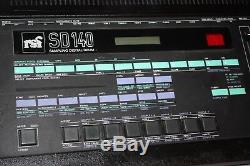
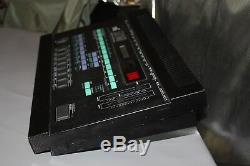
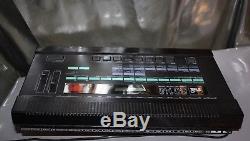
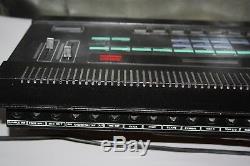
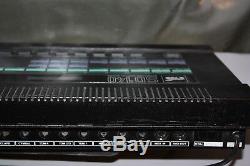
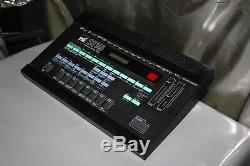

Up for sale a unique extremely rare vintage drum machine. Impossible to find it in another place. Many years ago I found this diamond and made the service in a professional workshop. These are the first innovative electronic music devices and therefore you can see in the pictures the old technology of plastic coatings and touch buttons have traces of use, but all functions and buttons are well work. It runs on 220 volt AC. The sound of this beast is very unique, the sound structure and flow are capable of creating incredible emotions and creative potency. The sound is incredibly relevant, I give a detailed description below. You might well have heard the RSF name before; they have been known in the past to a select few for their high-class synthesizers, including the programmable Kobol and Polykobol models.
Most of this select minority lived in France, not because they had particularly strong ideas about diet or the degree of wine consumption required from a real musician, but because previous RSF products hardly ever crossed the French border. But it's the new stablemate of the DD30 that we are investigating here - the SD140 - and it's no exaggeration to say that the unit came as something of a shock when it was previewed at the Paris Music Fair late in 1986.
It looked like a Yamaha RX15, it functioned like a Casio RZ-1, and it sounded like Carl Palmer with a whole symphony orchestra as backing. So what's the SD140's secret?The secret, of course, is user sampling, and with this facility built in the RSF SD140 joins the select ranks of drum machines which allow you to quickly and easily load up any sound you desire. All the aforementioned machines save their samples (whether to disk or to tape) except the Korg unit, which for some reason can't save them at all and forgets the lot after ten days!
So the market has been wide open for a fully-specified, reasonably priced, sampling drum machine. It offers 14 user sampling memories of various lengths, sample dump-to-tape (or via MIDI to a computer or other data recorder), and all the usual composition and synchronisation facilities. It also comes with a fairly impressive set of built-in sounds to get you started, and so an initial demo - particularly with some tuned brass and bass guitar effects as well as drums - can give you that'orchestra plus Carl Palmer' effect with no trouble at all. Let's zoom in on the control panel and see how the SD 140 does it. To the left of the control panel you'll find a square button marked'Upper/Lower' which helps select alternative sounds.
The sounds themselves are accessed via seven more buttons plus an Accent button for a programmably higher level; each pad has one Upper and one Lower sound accessible from it. To the right of the panel is a larger button marked'Play/Stop' which has an LED mode indicator and which also doubles up as the Sampling Start control. Above this button are sliders for Sample Input level and Master Output volume, and there are two displays - a two-digit LED and a long LCD. The rest of the control functions use Yamaha DX7-style membrane pushbuttons, which you either love or hate. The initial sounds provided by RSF are generally of pretty good quality.
Tom 1 Tom 2 Tom 3 Tom 4 Cymbal Claps Perc1. Bass Snare Rim C/HiHat O/HiHat Perc2 Perc3. The bass is snappy and modern, the snare fairly crisp, the cymbals bright and penetrating, the clap not very realistic, and the percussion sounds (shakers and so on) perfectly respectable. The tom sounds, however, were a bit duff on the review model - apparently they were taken from the earlier DD30 model and are due to be updated.Of course, the whole point of a sampling drum machine is that you can carry out such updating yourself. Rather than struggling to make a bit of spare memory available for sampling, the SD140 allows you to replace any of its built-in sounds with a sample of equal length (after saving them, of course). This means that there's little point trying to fit a long synthetic crash cymbal sound into the bass drum'slot' because the allotted memory will be too short, and this is a pity in some ways, because certain slots have more facilities than others. But we're getting ahead of ourselves..
The compositional side of the SD140 is very standard and very straightforward, so we'll take a brief look at that later. More unusual is the page-oriented layout of the alternative functions, the pages being called up using the Page Select button near the Master Volume control.The four pages available are: Pattern/Song, In/Outs, MIDI, and Sampling, with many of the control buttons having alternative functions according to what page you've accessed. On the MIDI page you can select MIDI In and Out channels, decide whether the SD140 responds to external MIDI clocks, assign MIDI note numbers to sounds so that you can trigger them externally from a keyboard or MIDI drum pad(s), transmit System Exclusive data, and so on. If you're on the In/Outs page, some of the same controls decide whether the SD140 responds to an external non-MIDI clock (24/48/96 ppqn), or to a tape pulse.
On the subject of outputs, the SD140 has lots - one for every sound except Toms 2/3, Open/Closed HiHat, and Snare/Rim which share outputs. All these are on jacks except the MIDI sockets - the only obvious omission, therefore, is a dedicated headphone socket. The rear panel sockets are labelled on the top of the machine as well as the back, for convenience, and once connected up, you'll find the SD140 very easy to use.
There are some impressive demo songs which are activated simply by choosing Pattern/Song mode, pushing two of the top row of membrane buttons to select a Song number, and hitting Start. Let's suppose you want to get straight into creating your own rhythm patterns and songs with the factory-supplied sounds rather than playing with the sampling facilities. This is possible using either real-time or step-time recording methods, and you can choose beat quantisation values up to 1/192 in the former case. As with most other digital drum machine designs, to programme the RSF you first choose an empty pattern memory, enter a time signature (such as 4/4 or 7/8), then a number of patterns, then start the metronome before tapping in beats using the pads.
You can erase whole patterns or single beats, although in the former case you have to tap all seven instrument pads while in Erase mode in order to do so. Once you're happy with your first pattern you can choose another, then another and, when you have enough, set about the task of creating a Song. By pushing the Song button you can enter pattern numbers followed each time by Enter, ending with the End button (nothing surprising here).
The SD140's capacity is 99 songs comprising up to 255 patterns chosen from a set of 99, so you're unlikely to run out of memory space. Patterns of Songs can be edited in many ways - for instance, it's easy enough to Delete or Insert patterns after you've created a Song. As far as individual patterns go, the possibilities include copying them from one memory to another (for a more logical arrangement, or if you want to create a variation which is substantially similar to an existing pattern), adding a Swing factor to help create a'human feel' from slightly syncopated to blatantly drunk! Oddly enough, the term'Punch' printed on one control doesn't refer to an ability to punch in to make an overdub, but to the Tape Save function. Load, Verify and Punch somehow doesn't convey the same meaning as Load, Verify and Save? We must put that one down to the idiosyncracies of the French language.. On to the sampling facilities, and you'll be glad to hear that these are straightforward if limited in some ways. Choose Page 3 (Sampling) and you'll find that the LED display becomes a simple input level VU meter with manual triggering offered by the Sampling Start button.Autostart is also available, and all you have to do to record your sample correctly is to choose'Memory' and tap the appropriate playing button. As previously mentioned, if you're creating a new bass drum sound you'd be best advised to record it over the existing bass drum, although if it has a lot of ambience you could try recording it into the snare slot but then where do you put your snare? If you're creating a very ambient snare, a cymbal or a long sound effect, you'll need to use the Cymbal memory which can accommodate a 1.6 second long sample (which is more than it sounds).
In fact, there aren't 14 independent sample memories, as RSF would have you believe. A single sample is replayed at four different pitches to create the four Toms, while another is played back in full with truncated versions to create the open and closed HiHats.
Other than those, every sound can be independently replaced with your own sample which will remain in memory and which can be saved via MIDI. Apart from their lengths, all sample memories are unequal in other ways - the Hi Hat has programmable decay, whilst the Tom, Cymbal and Bass Drum have programmable low-pass filtering. If you want to take advantage of these facilities, for instance to clean up a noisy sample taken from a cassette, you'll have to think carefully about where in the memories you're going to assign your sounds.
Another problem is sample tuning. A sample tune facility is provided (you can't miss it - it's called Sample Tune), but all it does is take every sound on the machine up or down in pitch over a potential range of two octaves shades of the old MXR drum machine? This is not very much use if you want to try to play a tune with your sampled brass sounds, and reduces you to the same state as a Casio RZ-1 owner who would have to record four different samples at different pitches and replay tunes using just these four notes. If Sequential could offer programmable pitch, panning and volume on every beat for every sound on their SCI Tom machine three years ago, why can't RSF do it now? Once you've composed your patterns you can enter a sort of live mixing mode in which the first ten switches on the top row select a sound and the Off/No, On/Yes buttons alter its level, independently of the other sounds.
Sounds can be accented or muted, but the options here are less flexible than on, say, the Korg DDD-1 or the Yamaha RX5. In terms of accessories and add-ons, the only obvious one is a start-stop footswitch, but there are some interesting computer sample editing packages on the way. Written by an independent French company, the first package is already available and offers storage and manipulation of sample dump data and gives you the ability to build up a large library of samples for the RSF SD140.Also on its way (but not available at the time of writing) is a visual editing package specifically for the SD140 which allows sample waveforms to be displayed and manipulated, something you otherwise can't do on-board. In fact, the lack of sample manipulation facilities is one of the most annoying features of the SD140. Since you have no means of cutting anything off the start or end of a sample, you have to have perfectly clean sounds to begin with (unless you let the end of the memory space available do the cutting for you). Unfortunately, not many records or compact discs feature completely isolated drum sounds or instrumental sounds, so you're more or less reduced to setting up your own sound sources to sample (if you could afford to hire a 96-piece orchestra you probably wouldn't want a sample of one) or using commercial sampling tapes. The other annoying feature of the machine is the way that the Page assignment works.
It's easy enough to find your way around the machine, but if you do select a page - say, Page 3, to adjust the MIDI note assignment - you'll find the SD140 slipping back into Play mode quite spontaneously after around eight seconds. This means that if your attention wanders for a few seconds you can find yourself selecting a completely different pattern instead of continuing the task you were working on, which is irritating in the extreme. The RSF SD 140 is on the whole very straightforward to use (even when, as with the review model, someone forgets to include the handbook).
The sampling routine is simple and relatively generous in its memory potential if not its editing capabilities. The lack of fully programmable tuning, panning and dynamics on the machine, however, seems like a retrograde step into the Stone Age, but the machine's MIDI implementation is good and the basic sounds I found impressive.
The quality of those samples you make yourself is, of course, very much up to your skill and creativity - I used several of the Dolby C metal'Star Samples' tapes and was very impressed by the SD140's fidelity, lack of hiss, and ability to sample a wide range of sound sources from cymbals and gongs to sharp, transient toms and Latin percussion, with no trace of distortion. The SD 140 is one of those machines you just have to check out for yourself. However, it does offer a full kit combining factory or user sounds with easy operation, good synchronisation facilities and multiple audio outputs, and so has every chance of being used and appreciated by many home and professional studios. The item "UNIQUE SUPER RARE RSF SD-140 VINTAGE Drum Machine TR808 909 killer" is in sale since Sunday, March 24, 2019. This item is in the category "Musical Instruments & Gear\Percussion\Drums\Electronic Drums". The seller is "polivoks-global" and is located in RU.This item can be shipped worldwide.
- Model: SD-140
- Country/Region of Manufacture: Japan
- Brand: RSF
- Drum Type: Drum Machines

